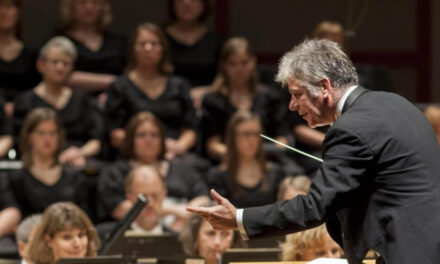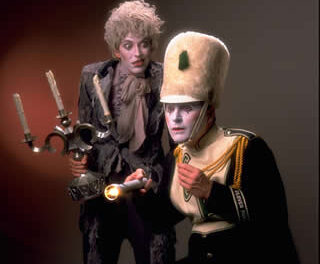One of the benefits of an arts presenter like Duke Performances is they have the backing and imprimatur of an enormous and influential educational institution and all the perks which that implies. Along with that, at least partially, comes the responsibility of serving as the artistic educational arm of the university. Under the still relatively new helm of Aaron Greenwald, Director of Duke Performances, the organization has presented a spectacular and diverse series of events that not only bring some of the biggest names in music, dance, theater and multimedia to the community but also exposure to representatives of art from cultures that we might not othewise experience. At Page Auditorium we heard a prime example of this type of event: the world premiere of Aswat (Voices) Celebrating the Golden Age of Arab Music featuring Simon Shaheen conducting the Aswat Orchestra well as four of the most renowned singers from the Arabic vocal tradition.
This was not just a fly-in/fly-out booking. This entire group flew in from New York on Monday during one of the worst weather days of this winter and spent the next three days as artists-in-residence at Duke University both developing this new and creative program and meeting with students, faculty and community members. The culmination was tonight’s event which served as somewhat of a dress rehearsal as they would then hit the road for ten more concerts all over the country.
Mr. Shaheen, artistic director of this group, is an accomplished musician trained in both traditional Arabic as well as western classical music, and is a virtuoso player on both the oud (a Middle Eastern instrument that is the precursor to the European lute) and the violin. He directed an ensemble that consisted of five violinists, including himself, a cellist and bass player – these are the more familiar western components of the orchestra.
The other instruments, which are primarily the ones that give the orchestra the sound we identify as Arabic or middle-eastern, are the qanun, a trapezoid-shaped, zither-like instrument, the wooden flute-like ney, the oud, plus several percussion instruments.
The evening began with a video montage featuring musical selections from films that were made during the “golden age” of Egyptian cinema – from the 1920s to the 1950s.
As Mr. Shaheen would later explain, the acting was quite awful but the music was quite representative of the great traditions of Egypt, Lebanon, Syria and other parts of the Arab world. He developed this program to commemorate and pay homage to this music that was featured in the movies of that era – particularly the unique vocal style that is instantaneously recognizable as Arabic. After Mr. Shaheen’s very informative preamble to the evening’s performance we heard an instrumental selection called “Fakkaruni” by Mohammed Abdel Wahhab. The distinctive modal scales, the piercing timbre of the qanun and oud, plus the simple but colorful percussion gave us all a Dorothy moment that we were not in Vienna anymore.
The concert proceeded with the four guest singers, all giants in their field, fronting the band so to speak. Mr. Khalil Abonula was first and he displayed remarkable vocal melismas so integral to this style. He was later joined by Rima Khcheich who was equally compelling and captivating. During the entire concert Mr. Shaheen was clearly in charge as he remained standing and served as conductor, violinist, backing vocalist and general overseer of the entire production. When there was some feedback he ominously glared at the soundboard controllers and pronounced “good boy” when it was cleared up.
Publicly berating a section violinist for briefly whispering during one of his talks left a feeling of unease.
This was a fascinating and rare opportunity to get an authentic aural glimpse into a musical world that few westerners understand, including this author, other than, perhaps, cinema stereotypes of belly dancers. I would be lying if I said that each selection completely engaged me or that I was able to discern any real differences. But make no mistake that is my cultural ignorance – we, especially in the western world, tend to dismiss or derisively say that “it all sounds the same” just as I’m sure that others might say the same for a Haydn string quartet and a Mahler symphony. The important thing is that we are exposed to the music of different cultures by experienced and serious-minded proponents of that art, and we make the effort to listen and understand. That goal was met with high marks and it piqued my interest and understanding. The only suggestion I would make is there be some editing of the program. The complete performance ran close to three and one/half hours and many fled after the intermission came at 10:05.












